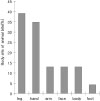Abstract
Purpose
This study aims to investigate preexposure prophylaxis and postexposure prophylaxis of rabies that the National Medical Center (NMC) handled and to check whether appropriate measures were performed according to the recent domestic and overseas guidelines after animal bites.
Methods
This study surveyed 41 people who were 18 years or under and received preexposure and postexposure prophylaxis of rabies at the NMC from November 2006 to December 2011. Their medical records were reviewed for their age, gender, the reason for preexposure prophylaxis, the body sites of animal bite, the kind of the animal that bit children, the region where the biting occurred and rabies vaccination and inoculation of immunoglobulin.
Results
Eleven children took rabies vaccination for preexposure prophylaxis and 30 children received post exposure prophylaxis of rabies. Of patients who were bitten by unvaccinated animals including wild animals or by animals which were not certain to be vaccinated, 50% (13 of 26 children) received postexposure prophylaxis, while 75% (3 of 4 children) of patients who were bitten by vaccinated animals received postexposure prophylaxis of rabies. Ten of 30 bitten patients knew whether or not the biting animals had received rabies vaccination. Of them, four people (40%) were bitten by animals which had received rabies vaccination.
Figures and Tables
References
1. Park JS, Han MG. General features and post-exposure prophylaxis of rabies. Infect Chemother. 2010. 42:6–11.

2. WHO Expert consultation on Rabies. WHO Technical report Series 931. 2005. Geneva, Switzerland: WHO;[available at http://www.who.int/rabies/trs931%200605.pdf].
3. Korea Centers for Disease Control and Prevention. Cases of animal biting occurred in rabies risk regions in 2008 and risk factors for the development of rabies. Public Health Wkly Rep. 2009. 14:217–220.
4. Johnson N, Cunningham AF, Fooks AR. The immune response to rabies virus infection and vaccination. Vaccine. 2010. 28:3896–3901.

6. Jackson AC, Phelan CC, Rossiter JP. Infection of Bergmann glia in the cerebellum of a skunk experimentally infected with street rabies virus. Can J Vet Res. 2000. 64:226–228.
7. Fooks AR, Johnson N, Freuling CM, Wakeley PR, Banyard AC, et al. Emerging technologies for the detection of rabies virus: challenges and hopes in the 21st century. PLoS Negl Trop Dis. 2009. 3:e530.

8. Susilawathi NM, Darwinata AE, Dwija IB, Budayanti NS, Wirasandhi GA, Subrata K, et al. Epidemiological and clinical features of human rabies cases in Bali 2008-2010. BMC Infect Dis. 2012. 12:81.

9. Korea Centers for Disease Control and Prevention. Human rabies prevention and control. 2007. Seoul: Korea Centers for Disease Control and Prevention;5–65.
11. Kim CH, Lee CG, Yoon HC, Nam HM, Park CK, Lee JC, et al. Rabies, an emerging disease in Korea. J Vet Med B Infect Dis Vet Public Health. 2006. 53:111–115.

12. Yang DK, Kim SY, Oh YI, Lee JA, Cho SD, Lee KW, et al. Epidemiological characteristics of rabies in South Korea from January 2004 to March 2011. J Bacteriol Virol. 2011. 41:165–171.

13. Han MG. Animal bite cases in high-risk region of rabies, 2010. Public Health Wkly Rep. 2011. 4:481–485.
14. Jackson AC, Warrell MJ, Rupprecht CE, Ertl HC, Dietzschold B, O'Reilly M, et al. Management of rabies in humans. Clin Infect Dis. 2003. 36:60–63.

15. Wilde H, Hemachudha T, Jackson AC. Viewpoint: Management of human rabies. Trans R Soc Trop Med Hyg. 2008. 102:979–982.

16. World Health Organization (WHO). Current WHO guide for rabies pre- and post-exposure treatment in humans. 2002. accessed on 21 August 2012. Geneva: WHO;www.who.int/entity/rabies/en/WHO_guide_rabies_pre_post_exp_treat_humans.pdf.
17. Dodet B. Asian Rabies Expert Bureau. An important date in rabies history. Vaccine. 2007. 25:8647–8650.

18. Warrell MJ. Current rabies vaccines and prophylaxis schedules: preventing rabies before and after exposure. Travel Med Infect Dis. 2012. 10:1–15.

19. The Korean Pediatric Society. Lee HJ, editor. Rabies Vaccination. Immunization Guideline. 2012. 7th ed. Seoul: The Korean Pediatric Society;224–230.
20. Rupprecht CE, Briggs D, Brown CM, Franka R, Katz SL, Kerr HD, et al. Centers for Disease Control and Prevention. Use of a reduced (4-Dose) vaccine schedule for postexposure prophylaxis to prevent human rabies, 2010: recommendations of the Advisory Committee on Immunization Practices (ACIP). MMWR Recomm Rep. 2010. 59(RR-2):1–9.
22. Strady C, Andreoletti L, Baumard S, Servettaz A, Jaussaud R, Strady A. Immunogenicity and booster efficacy of pre-exposure rabies vaccination. Trans R Soc Trop Med Hyg. 2009. 103:1159–1164.

23. Yang DK, Yoon SS, Lee KK, Byun JW, Bae YC, Oh YI, et al. Rabies immune status in the stray and companion dogs in Korea. Korean J Vet Res. 2010. 50:133–137.




 PDF
PDF ePub
ePub Citation
Citation Print
Print






 XML Download
XML Download